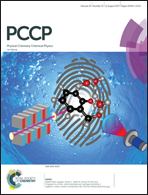Silver–gold alloy nanoparticles as tunable substrates for systematic control of ion-desorption efficiency and heat transfer in surface-assisted laser desorption/ionization†
Abstract
Systematically controlling heat transfer in the surface-assisted laser desorption/ionization (SALDI) process and thus enhancing the analytical performance of SALDI-MS remains a challenging task. In the current study, by tuning the metal contents of Ag–Au alloy nanoparticle substrates (AgNPs, Ag55Au45NPs, Ag15Au85NPs and AuNPs, ∅: ∼2.0 nm), it was found that both SALDI ion-desorption efficiency and heat transfer can be controlled in a wide range of laser fluence (21.3 mJ cm−2 to 125.9 mJ cm−2). It was discovered that ion detection sensitivity can be enhanced at any laser fluence by tuning up the Ag content of the alloy nanoparticle, whereas the extent of ion fragmentation can be reduced by tuning up the Au content. The enhancement effect of Ag content on ion desorption was found to be attributable to the increase in laser absorption efficiency (at 355 nm) with Ag content. Tuning the laser absorption efficiency by changing the metal composition was also effective in controlling the heat transfer from the NPs to the analytes. The laser-induced heating of Ag-rich alloy NPs could be balanced or even overridden by increasing the Au content of NPs, resulting in the reduction of the fragmentation of analytes. In the correlation of experimental measurement with molecular dynamics simulation, the effect of metal composition on the dynamics of the ion desorption process was also elucidated. Upon increasing the Ag content, it was also found that phase transition temperatures, such as melting, vaporization and phase explosion temperature, of NPs could be reduced. This further enhanced the desorption of analyte ions via phase-transition-driven desorption processes. The significant cooling effect on the analyte ions observed at high laser fluence was also determined to be originated from the phase explosion of the NPs. This study revealed that the development of alloy nanoparticles as SALDI substrates can constitute an effective means for the systematic control of ion-desorption efficiency and the extent of heat transfer, which could potentially enhance the analytical performance of SALDI-MS.



 Please wait while we load your content...
Please wait while we load your content...